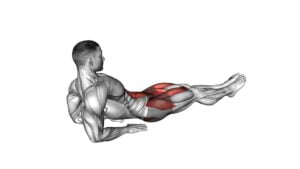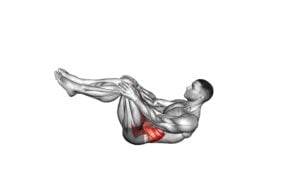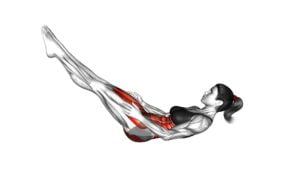Lying Knee Tuck (male) – Video Exercise Guide & Tips

In this video exercise guide, you'll learn all about the lying knee tuck and how it can benefit you.
Watch This Exercise Video
This is a great exercise for targeting your core and lower abdominal muscles.
You'll discover the proper form and technique to ensure you're getting the most out of each rep.
Plus, we'll share variations to increase the difficulty and common mistakes to avoid.
Get ready to take your workout to the next level with the lying knee tuck!
Key Takeaways
- Proper form and technique are important for the lying knee tuck exercise, including keeping the lower back pressed against the floor and avoiding lifting the shoulders off the ground.
- Gradual progression is recommended, starting with a comfortable range of motion and increasing it as strength improves, to avoid injury and ensure steady progress.
- Engaging the core muscles during the exercise helps to strengthen the rectus abdominis, obliques, and transverse abdominis, while also improving stability, balance, and posture.
- Variations can be used to increase the difficulty of the exercise, such as using weights, suspension trainers, or performing on a decline bench, and individuals should choose a variation that suits their fitness level and gradually progress.
Benefits of Lying Knee Tuck
Improve your core strength and stability with the lying knee tuck exercise. This exercise is an effective way to strengthen your core and engage your abdominal muscles. By performing the lying knee tuck, you can target your rectus abdominis, obliques, and transverse abdominis, which are essential for a strong and stable core.
The lying knee tuck is a core strengthening exercise that involves lying on your back with your knees bent and feet flat on the ground. From this starting position, you'll slowly lift your knees towards your chest, curling your pelvis and engaging your abdominal muscles. As you lift your knees, focus on maintaining a strong core and avoiding any excessive movement in your lower back.
This exercise provides an intense abdominal workout as it requires the activation of multiple core muscles simultaneously. By regularly incorporating the lying knee tuck into your fitness routine, you can improve your core strength, stability, and overall posture.
To ensure proper form and technique during the lying knee tuck exercise, it's important to maintain a neutral spine and avoid straining your neck or shoulders. Focus on controlled movements and engage your core muscles throughout the exercise. By following these guidelines, you can maximize the benefits of the lying knee tuck and prevent any potential injuries.
Proper Form and Technique
To maintain proper form and technique during the lying knee tuck exercise, focus on keeping a neutral spine and avoiding strain on your neck or shoulders.
Many people have common misconceptions about this exercise, so it's important to understand the correct form to maximize its benefits and minimize the risk of injury.
First, lie on your back with your knees bent and feet flat on the floor. Your arms should be extended by your sides, palms facing down. This is the starting position.
As you initiate the movement, engage your core muscles and lift your feet off the ground, bringing your knees towards your chest. Keep your lower back pressed against the floor and avoid arching or rounding your spine. This will help maintain a neutral spine throughout the exercise.
Another key aspect of proper form is to avoid straining your neck or shoulders. To do this, focus on keeping your head and neck relaxed, with your gaze directed towards the ceiling. Avoid pulling on your neck with your hands or using your shoulders to lift your legs. Instead, rely on your abdominal muscles to control the movement and lift your knees towards your chest.
No equipment is needed for the lying knee tuck exercise, making it a convenient option for home workouts or when you don't have access to a gym. Just find a comfortable space on the floor and you're ready to go.
Variations to Increase Difficulty
To challenge yourself further and increase the difficulty of the lying knee tuck exercise, you can try different variations that target your core muscles in new ways. Here are some advanced modifications and equipment options to consider:
- Weighted Knee Tuck: Hold a dumbbell or a medicine ball between your feet while performing the knee tuck. This added weight will intensify the exercise and engage your core muscles even more.
- Suspension Trainer Knee Tuck: Attach a suspension trainer, such as TRX, to a sturdy anchor point. Place your feet in the straps and perform the knee tuck while maintaining stability and control. This variation challenges your core stability and coordination.
- Decline Bench Knee Tuck: Position yourself on a decline bench with your head lower than your feet. Perform the knee tuck, lifting your knees towards your chest. This modification increases the resistance and places more emphasis on your lower abs.
- Single Leg Knee Tuck: Lift one leg off the ground and perform the knee tuck with the other leg. This variation adds instability and requires greater core strength and balance.
Remember to choose a variation that suits your fitness level and gradually progress as you become more comfortable and stronger. Incorporating these advanced modifications and equipment options will help you take your lying knee tuck exercise to the next level and maximize your core muscle engagement.
Common Mistakes to Avoid
Avoid these common mistakes when performing the lying knee tuck exercise to ensure proper form and maximize your results.
One common mistake to avoid is lifting your head off the ground. When you lift your head, you put unnecessary strain on your neck and decrease the effectiveness of the exercise. Keep your head and neck in a neutral position throughout the movement.
Another mistake isn't engaging your core muscles properly. To perform the lying knee tuck correctly, you need to contract your abdominal muscles and draw your belly button towards your spine. This helps to stabilize your body and target the muscles in your core.
Additionally, be careful not to use momentum to swing your legs up. This takes away from the challenge and reduces the effectiveness of the exercise. Instead, focus on using controlled movements to lift your knees towards your chest.
Lastly, avoid allowing your lower back to arch excessively. This can strain your lower back and take away from the targeted muscle engagement. Keep your lower back pressed firmly against the ground throughout the exercise.
Tips for Getting the Most Out of Your Lying Knee Tuck Workout
Maximize the effectiveness of your lying knee tuck workout by incorporating these helpful tips:
- Focus on Proper Breathing:
While performing the lying knee tuck, it's crucial to pay attention to your breathing. Inhale deeply before you start the movement and exhale as you bring your knees towards your chest. This controlled breathing helps to engage your core muscles and maintain stability throughout the exercise.
- Engage Your Core:
The lying knee tuck primarily targets your core muscles, so it's essential to engage them properly. Before you start the exercise, consciously tighten your abdominal muscles. This engagement won't only enhance the effectiveness of the workout but also protect your lower back from strain.
- Maintain Proper Form:
To get the most out of your lying knee tuck, ensure that you maintain proper form throughout the exercise. Keep your lower back pressed against the floor, and avoid lifting your shoulders off the ground. This will ensure that you're effectively targeting your core muscles and minimizing the involvement of other muscle groups.
- Progress Gradually:
If you're new to lying knee tucks or have weak core muscles, it's important to progress gradually. Start with a comfortable range of motion and gradually increase it as your strength improves. This approach will help you avoid injury and ensure steady progress.
Frequently Asked Questions
How Many Calories Can I Expect to Burn by Doing Lying Knee Tucks?
By doing lying knee tucks, you can expect to burn a significant amount of calories. These exercises target multiple muscle groups, including your abs, hip flexors, and lower back, which increases your caloric expenditure.
Lying knee tucks are highly effective for strengthening your core and improving your overall fitness. Incorporating them into your workout routine can help you burn calories and achieve your fitness goals more efficiently.
Can Lying Knee Tucks Help Improve My Posture?
Lying knee tucks can indeed help improve your posture. When you perform this exercise, it engages your core muscles and strengthens your abdominal region, which plays a crucial role in maintaining proper posture.
Additionally, lying knee tucks also target your hip flexors, which can become tight and cause poor posture. By regularly incorporating this exercise into your workout routine, you can enjoy the benefits of improved posture and a stronger core.
Are There Any Modifications for Individuals With Knee or Lower Back Issues?
If you have knee or lower back issues, there are modifications you can make for the lying knee tuck exercise.
To protect your knees, you can place a cushion or folded towel under them for added support.
For lower back issues, you can try bending your knees slightly or placing a small pillow under your lower back to reduce strain.
These modifications can help you perform the exercise safely and avoid exacerbating any existing issues.
Can Lying Knee Tucks Help Improve My Core Strength?
Lying knee tucks can definitely help improve your core strength. By engaging your abdominal muscles, this exercise targets your rectus abdominis, obliques, and hip flexors. The benefits of lying knee tucks include increased core stability, improved balance, and enhanced overall athletic performance.
There are variations of lying knee tucks that you can incorporate into your workout routine, such as adding resistance bands or performing the exercise on an unstable surface like a Swiss ball.
Is It Necessary to Use a Mat or Can I Perform Lying Knee Tucks on a Hard Surface?
When doing lying knee tucks, it's important to consider whether to use a mat or perform them on a hard surface.
Using a mat provides benefits such as cushioning, support, and grip, which can enhance your exercise experience.
However, performing lying knee tucks on a hard surface is also possible, but it may be less comfortable and may put more strain on your joints.
Ultimately, the choice between a mat and a hard surface depends on your personal preference and comfort level.
Conclusion
In conclusion, the lying knee tuck exercise is an effective way to strengthen your core and improve your overall fitness. By following proper form and technique, you can maximize the benefits of this exercise and avoid common mistakes.
Additionally, incorporating variations can increase the difficulty level and challenge your muscles even further. Remember to listen to your body, avoid overexertion, and consult with a fitness professional if necessary.
Get ready to feel the burn and enjoy the results of your lying knee tuck workout!

Author
Years ago, the spark of my life’s passion ignited in my mind the moment I stepped into the local gym for the first time. The inaugural bead of perspiration, the initial endeavor, the very first surge of endorphins, and a sense of pride that washed over me post-workout marked the beginning of my deep-seated interest in strength sports, fitness, and sports nutrition. This very curiosity blossomed rapidly into a profound fascination, propelling me to earn a Master’s degree in Physical Education from the Academy of Physical Education in Krakow, followed by a Sports Manager diploma from the Jagiellonian University. My journey of growth led me to gain more specialized qualifications, such as being a certified personal trainer with a focus on sports dietetics, a lifeguard, and an instructor for wellness and corrective gymnastics. Theoretical knowledge paired seamlessly with practical experience, reinforcing my belief that the transformation of individuals under my guidance was also a reflection of my personal growth. This belief holds true even today. Each day, I strive to push the boundaries and explore new realms. These realms gently elevate me to greater heights. The unique combination of passion for my field and the continuous quest for growth fuels my drive to break new ground.







